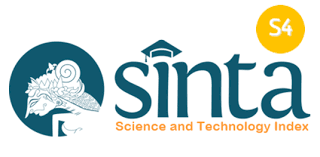KAJIAN PENERAPAN METODE ADVANCED OXIDATION PROCESS (AOPS) PADA PENGOLAHAN LIMBAH CAIR DI INDONESIA
Main Article Content
Abstract
Meningkatnya jumlah penduduk dan industri di Indonesia berkolerasi positif denganjumlah dan jenis limbah yang dihasilkan sehingga pengolahannua akan semakin menantang. Untuk mengatasi hal tersebut, Metode Advanced Oxidation Processes (AOPs) mulai banyak dikembangkan karena memiliki beberapa kelebihan dibandingkan dengan metode lain. Di Indonesia, literatur yang mengkaji penerapan metode AOPs masih sedikit. Oleh karena itu, perlu dilakukan kajian mengenai penerapan metode AOPs di Indonesia sehingga dapat memberikan kontribusi keilmuan terkait penerapan metode AOPs. Berdasarkan hasil kajian diketahui bahwa, sistem AOPs yang diterapkan di Indonesia, antara lain sonochemical, fenton, peroxymonosulfate/Katalis, UV/H2O2, UV/H2O2/TiO2, O3/ H2O2, O3/GAC, UV/Fenton/Katalis, fotofenton dan elektronfenton. Sistem tersebut memiliki prinsip kerja yang serupa yaitu memproduksi radikal bebas untuk mendegradasi kontaminan. Akan tetapi terdapat perbedaan yang jelas diantara nya metode tersebut dalam memproduksi radikal bebas tersebut. Selaian itu, efisiensi penurunan pencemar sistem AOPs juga berbeda-beda tergantung jenis sistem AOPs yang dipakai serta faktor-faktor lain seperti kondisi pH, waktu reaksi, konsentrasi H2O2, konsentrasi reagen Fe, konsentrasi PMS, variasi debit udara, feeding rate ozon, dosis GAC, perbandingan molar H2O2:FeSO4, dosis katalis, tegangan listrik, jarak elektroda, rasio H2O2/COD dan lain-lain. Sistem AOPs yang diterapkan di RSUD Banyumas yaitu sistem O3/UV ditambah media sarang tawon dengan efisiensi penyisihan pencemar BOD 41,67%; COD 33,3%; TSS 26,67%; Minyak dan lemak 37,5% serta Total Coliform 79,17%. Sementara itu, sistem AOPs yang diterapkan di TPA Benowo adalah sistem O3/UV/H2O2 ditambah nanofilter dengan efisiensi penyisihan pencemar BOD 94,63%; COD 94,68%; TSS 95,24%; N-Total 96,71% dan Merkuri 46,15%.
Downloads
Article Details
Submission of a manuscript to Jurnal Purifikasi means that the work has never been published in another journal and is not under consideration for publication elsewhere. The author hereby agrees to submit the copyright of the manuscript and its contents to Jurnal Purifikasi, if accepted for publication. Accepted manuscripts will be published in printed form where the ISSN is bound in printed form, not in online form (pdf). Authors are not allowed to publish their work in other forms (journals) without permission from the Jurnal Purifikasi manager.
By submitting a manuscript, the author is deemed to know all the rights and obligations attached to each manuscript.








